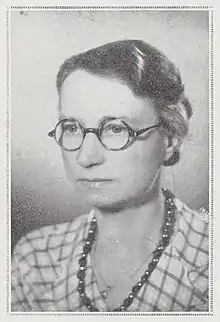Marie Léonie Vanhoutte | |
|---|---|
 Vanhoutte (1937) | |
| Born | 13 January 1888 |
| Died | 4 May 1967 (aged 79) |
| Other names | Charlotte Lameron, Marie-Leonie Vanhoutte, Leonie van Houtte |
| Spouse | Antoine Rédier (m. 1934–1954, death) |
Marie Léonie Vanhoutte, also known by the pseudonym Charlotte Lameron (1888 – 1967)[1] was a French Resistance fighter and secret agent during World War I who worked at the French-Belgium border.[2]
Early life
Marie Léonie Vanhoutte was born on 13 January 1888 in Roubaix, France, in a house on Rue de la Vigne.[1][3]
At the start of World War I, she was a nurse trainee at the Red Cross, but she did not stay long at that role[3] since she did not want to treat the German soldiers medically.[4] She travelled to Flanders to identify the places of passage for resistance networks for the French and the British to cross German lines.[3] In August 1914 Vanhoutte was instrumental at planting ambulances and playing the role of "Charlotte Lameron".[5] There is varying information about her character role, with some sources state "Charlotte" worked as a cheesemonger, but others called her a Red Cross nurse.
Alice Network
She was put in contact with Louise de Bettignies (also known as "Alice Dubois") and they met at Prouvost-Masurel Castle, in Mouvaux.[3] In the spring of 1915, Vanhoutte started to help Bettignies in the Alice Network, also known as the Alice Circle, expand the espionage circuit to the nearby towns of Cambrai, Valenciennes and Saint-Quentin.[6][5] The networks were geographic areas, divided by sectors, to identify train passages, German troop movements, the location of ammunition stores and information regarding weaponry.[4][7] They would write reports, code messages and transmit the messages through Belgium and the Netherlands.[4] Vanhoutte was able to travel freely because of the ambulances and couriered the information to each location.[5]
On 24 September 1915, Vanhoutte was arrested, was sent to the Saint-Gilles prison in Brussels and was sentenced to 15 years.[3][5][8] The Germans used subterfuge to force Vanhoutte to identify Louise de Bettignies from photographs, which eventually resulting in Bettignies's arrest.[4][5] When World War I ended in 1918, Vanhoutte was freed from prison.
Vanhoutte married the writer Antoine Rédier on 19 July 1934 in Paris.[8][9] Attendees at their wedding included Maxime Weygand, André Tardieu and Henri Gouraud.[9]
Death and legacy
Vanhoutte died on 4 May 1967 in Boulogne-Billancourt. She is buried in Hauteville-sur-Mer,[1][10] where the village square is dedicated to her honour.[10]
In 1937, a film by Léon Poirier featured a Vanhoutte character, Soeurs d'Armes: Film (English: Sisters in Arms: Film). He also published a book related to the film.[11]
The 2017 historical fiction novel The Alice Network also featured a fictionalized version of Vanhoutte as a supporting character.
Awards
- Knight of the Legion of Honour (1927)[12]
- Croix de guerre 1914–1918 (1919)[10]
- Officer of the Legion of Honour (1966)
- Officer of the Order of the British Empire (1918)[3]
Further reading
- Proctor, Tammy M. (2003). Female Intelligence: Women and Espionage in the First World War. New York City, NY: NYU Press. ISBN 978-0814766934.
- Poirier, Leon (1937). Soeurs d'Armes [Sisters in Arms] (in French). Maison Mame.
- Rédier, Antoine (1923). La Guerre des Femmes. Histoire de Louise de Bettignies et de ses Compagnes. Les Éditions de la Vraie France.
References
- 1 2 3 "Vanhoutte, Marie-Léonie (1888-1967) international form". BnF.
- ↑ Halioua, Bruno (June 2014). "[Nurses and spies during the First World War]". Soins (786): 75–79. ISSN 0038-0814. PMID 25069364.
- 1 2 3 4 5 6 Gorez-Brienne, Sandrine; Vérizian-Lefeuvre, Corinne (2010). "Visions of an occupied Roubaix: between literature and history". Nord. 64: 109–127.
- 1 2 3 4 "Sur les actes du colloque « Les femmes pendant la Grande Guerre », organisé le 18 octobre 2018". www.senat.fr (in French). Retrieved 2021-07-01.
- 1 2 3 4 5 "27 September 1918 Louise de Bettignies (alias 'Alice Dubois') died on this day". The Western Front Association. Retrieved 2021-07-01.
- ↑ "Resistance to the first German occupation- Remembrance Trails of the Great War in Northern France". Northern France Battlefields Trail. Retrieved 2021-07-01.
- ↑ Stoughton, Patricia (July 2010). "Louise de Bettignies: the pro-British 'Joan of Arc' | History Today". History Today, Volume 60, Issue 7. Retrieved 2021-07-01.
- 1 2 "War Heroine Wed To French Writer". Newspapers.com. The Ottawa Journal. 20 July 1934. p. 8. Retrieved 2021-07-01.
- 1 2 "France: Smuggler's Marriage". Time. 1934-07-30. ISSN 0040-781X. Retrieved 2021-07-01.
- 1 2 3 "Marie-Léonie Vanhoutte, résistante de guerre" [Marie-Léonie Vanhoutte, war resister]. Ouest France.
- ↑ Soeurs d'armes : film, Léon Poirier (1884-1968) (in French). 1937.
- ↑ "27-2-27, Roubaix, le banquet, M. Tardieu [ministre des travaux publics, au centre], Mlle Léonie Vanhoutte [décorée de la Croix de chevalier de la Légion d'honneur] : [photographie de presse] / [Agence Rol]". Gallica. Agence Rol Agence (photographique). 1927. Retrieved 2021-07-01.
{{cite web}}: CS1 maint: others (link)